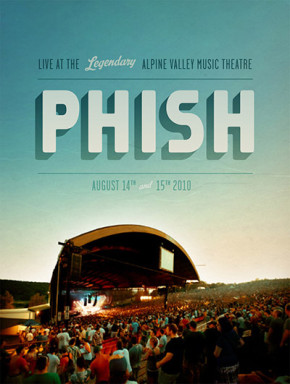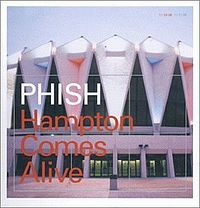Quinn the Eskimo (The Mighty Quinn)
| Originally Performed By | Bob Dylan |
| Original Album | Self Portrait (1970) |
| Appears On |


|
| Music/Lyrics | Bob Dylan |
| Vocals | Mike (lead), Page, Trey (backing) |
| Phish Debut | 1985-04-06 |
| Last Played | 2019-06-28 |
| Current Gap | 235 |
| Recommended Versions | 1998-12-28, 2011-07-01 |
| Historian | Jeremy D. Goodwin |
| Last Update | 2022-12-02 |
History
Is this song about a spiritual messiah of sorts, or just the ultimate hipster? Is there a difference? Either way, “Quinn’s” presence is enough to drag everyone away from his routine of feeding pigeons and stepping on everyone’s toes. This can be seen as the story of an oppressed and listless people awaiting their salvation, or perhaps a group of bored acid freaks awaiting their connection. Either way, through “Quinn’s” impending visit, they expect transcendence. (Sort of like the pre-show vibe at a Phish gig?) Dylan said that he intended the song to be like a “nursery rhyme,” but a screed against conformity and modern capitalism can be gleaned from the lyrics if one wishes. When the song opens, everyone is busy with tasks they don’t seem to enjoy, such as “building the big ships,” “building monuments, ”and “jotting down notes.” The singer admits that he’s been occupied with “guarding fumes and making haste,” and that this kind of life really isn’t his “cup of meat.” However, when Quinn arrives on the scene, everyone jumps for joy! Does the strength of his personality amuse the populace such that its members can lay aside the cares of their workaday lives? Does he provide some missing item that the people lack? Does he lead them, Pied Piper-like, towards some alternate existence? The answers are up to the imagination of the listener.
This fun and (perhaps) profound ballad originated in the legendary jam sessions that Bob Dylan and members of his touring group (later to dub themselves The Band) held in the basement of a rented house in Woodstock, NY. For several months over the summer and early fall of 1969, the Bard and his cohorts maintained a semi-regular schedule of afternoon wine and hashish consumption, followed by a few hours of playing and (sometimes) recording, with a fairly low tech, jerry-rigged technical setup, which usually lacked drums. Indeed, once and future drummer Levon Helm had quit the band during its famously maligned world tour backing Dylan in ’66. He wouldn’t return until his former cohorts invited him to return to record the album that would become Music From Big Pink. Dylan was recuperating from a near-fatal motorcycle accident and attempting to withdraw from the crucible of public attention in which he had been baking for several years. This period provided the breather he needed to recover personally and artistically from the amphetamine-fueled tightrope psychedelia of his mid-’60s albums (culminating in the “wild mercury sound” of Blonde on Blonde). The musical output of these “basement tapes” featured a unique melding of influences (Appalachian folk, English balladry, the Sun sessions, and Ginsberg-via-Dalí surreal hedonism) mixed into an oddly familiar, yet drastically fanciful stew that is authentically American, and can only be called Dylan-esque.
Phish fans would do well to note that these basement sessions quickly passed into the hands of collectors, and contributed to the genesis of the modern bootleg industry. Some of the tracks finally saw the light of day with the release of Basement Tapes on Columbia in 1974. This somewhat unfortunate compilation was overseen by Robbie Robertson, who inserted a disproportionate number of Band tunes, and went so far as to overdub onto some tracks. To this day, most of the sessions remain unreleased officially, though Dylanophiles can seek out various bootleg boxed sets containing most of the music known to be in circulation. These collections are vast improvements over the official version, and well worth whatever effort or expense their acquisition may entail.
As for Quinn, that mystic/socialite/good guy, his story surfaced on wax with the release of Self Portrait (the much criticized, genre-hopping two album set), which included a live version recorded at the Isle of Wight Festival. This obscure cut had less of a cultural impact than the Manfred Mann version, which charted in the Top Ten after the group was floated a demo tape of the song shortly after the actual basement sessions. The original “studio” version finally appeared in 1985 on the first-ever boxed set, Biograph.
"Quinn the Eskimo" – Phish, 12/28/98, New York, NYPhish included this number in its early repertoire of covers, but it was long abandoned by the time the band entered the “modern era” of the ‘90s. On 11/20/98, after an improbable flood of odd debuts and breakouts throughout the year had apparently trickled dry, the boys opened the floodgates once more for a celebratory exclamation mark: the return of “Quinn the Eskimo.” The gap between performances is one of the longest ever of a song in Phish’s repertoire: 1,151 shows. This first set kick-down sent a roar of appreciation through Hampton Coliseum (as if everyone wasn’t cranked up enough already), and some fans had an emotional moment when they realized that they had seen the Grateful Dead perform this song in the same room over ten years before.
The song appeared just three more times before disappearing again for over ten years. It finally reemerged as the encore in the pristine environs of Telluride Town Park on 8/9/10. Many have speculated that the Telluride bustout was a nod to the 15th anniversary of Jerry Garcia's death ("Quinn" was often covered by the Dead and was usually played in the encore slot). "Quinn" has since become part of the standard rotation, appearing with greater frequency than any time since the '80s. While most versions of "Quinn" are enjoyable, fans should be sure to check out the versions from 12/28/98, which segues nicely into “David Bowie,” and 7/1/11, which closes the first set of Super Ball IX with an exclamation point.
"Quinn the Eskimo" 7/1/11 Watkins Glen, NY

 The Mockingbird Foundation
The Mockingbird Foundation